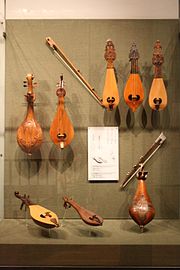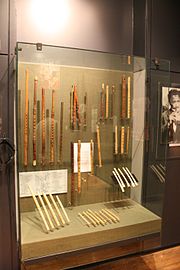- Greek folk music
-
Music of Greece General topics Ancient • Byzantine • Néo kýma • Polyphonic song Genres Entehno • Dimotika • Hip hop • Laïko • Punk • Rock Specific forms Classical • Nisiotika • Rebetiko • Skiladiko Media and performance Music awards Arion Awards • MAD Video Music Awards • Pop Corn Music Awards Music charts Greek Albums Chart • Foreign Albums Chart • Singles Chart Music festivals Thessaloniki Song Festival Music media Difono • MAD TV (MAD World, Blue) • MTV Greece National anthem "Hymn to Liberty" Regional music Related areas Cyprus Regional styles Aegean Islands • Arcadia • Argos • Crete • Cyclades • Dodecanese Islands • Epirus • Ionian Islands • Lesbos • Macedonia • Peloponnese • Thessaly • Thrace Greek folk music includes a variety of Greek styles played by ethnic Greeks in Greece, Cyprus, Australia, the United States and elsewhere. Apart from the common music found all-around Greece, there are distinct types of folk music, sometimes related to the history or simply the taste of the specific places.
Contents
Aegean Islands
Main articles: Nisiotika and Music of the Aegean IslandsThe Aegean islands of Greece are known for Nisiótika songs; Greek characteristics vary widely. Although the basis of the sound is characteristically secular-Byzantine, the relative isolation of the islands allowed the separate development of island-specific Greek music. Most of the Nisiótika songs are accompanied by lira, clarinet, guitar and violin. Modern stars include Yiannis Parios and the Konitopouloi ; Mariza Koch is credited with reviving the field in the 1970s. Folk dances include the Kalamatianos, ballos, syrtos, sousta, Chiotikos, Kalymniotikos, stavrotos, lerikos, kamara, mihanikos, trata, Panagia, Kalamatiano and Ikariotikos.
Central Greece
Main article: Music of central GreeceIn central Greece many of folk songs referred to Rumeli. Rumeli and peloponnese took the lead in Greek war of independence in 1821. The kind of music also, is more closed to the music of the Greek cities. Folk dances in central Greece include: antikrystos, syrtaki - Zorba's dance, rebetiko, Kalamatiano, zeibekiko, chasaposerviko, Kalamatianos, Kamilierikos Choros, Koulouriotikos, syrtos, tsamiko, choros tis tratas, Chatzichristos and syrtokalamatianos.
Crete
Main article: Music of CreteThe Greek islands of Kárpathos, Khálki, Kássos and Crete form an arc where the Cretan lyra is the dominant instrument. Kostas Mountakis is probably the most widely-respected master of the lira, which is often accompanied by the laoúto which resembles a mandolin. Bagpipes are often played on Kárpathos. Crete has a well known folk dance tradition, which comes from ancient Greece and includes swift dances like pentozalis and other like sousta, syrtos, trizali, Katsabadianos, Chaniotikos, siganos, pidichtos Lasithou, Maleviziotikos, tsiniaris, Ierapetrikos and Laziotikos.
Cyclades
Main article: Music of the CycladesIn the Aegean Cyclades, the violin is more popular than the Cretan lyra, and has produced several respected musicians, including Nikos Ikonomidhes, Leonidas Klados and Stathis Koukoularis.Folk dances in Cyclades include Kalamatianos, Kalamatiano, lerikos, syrtos, syrtos Serifou, syrtos Naxou, syrtos Kythnou, Amorgos dance and ballos. One of the most famous singers of cycladic music is Domna Samiou.
Cyprus
Main article: Music of CyprusCyprus is an independent country, currently contested between the Republic of Cyprus and the internationally unrecognized Turkish Republic of Northern Cyprus. Cyprus' folk traditions include dances like the sousta, syrtos, zeibekikos, and the karsilamades.
Dodecanese Islands
Main article: Music of the Dodecanese IslandsThere are prominent elements of Cretan music on the Dodecanese Islands. Dodecanese folk dances include the trata, ballos, syrtos, kremasti, issos, syrtos Rodou, mihanikos and Kalymnikos, with origin from the island of Kalymnos.
Epirus
Main article: Music of EpirusIn Epirus, folk songs are pentatonic and polyphonic,sung by both male and female singers. Distinctive songs include mirolóyia (mournful tunes) vocals with skáros accompaniment and tis távlas (drinking songs). The clarinet is the most prominent folk instrument in Epirus, used to accompany dances, mostly slow and heavy, like the tsamikos, koftos, menousis, fisouni, podhia, sta dio, sta tria, zagorisios, kentimeni, Metsovitikos, yiatros.
Ionian Islands
Main articles: Music of the Ionian Islands and kantádhesThe Ionian Islands were never under Ottoman control, and their Heptanesian kantádhes (Greek: καντάδες), are based on the popular Italian style of the early 19th century. Greek Kantádhes are performed by three male singers accompanied by mandolin or guitar. These romantic songs developed mainly in Kefallonia in the early 19th century but spread throughout Greece after the liberation of Greece. An Athenian form of kantádhes arose, accompanied by violin, clarinet and laouto. However the style is accepted as uniquely Ionian. The island of Zakynthos has a diverse musical history with influences mainly from Crete. The island's music heritage is celebrated by the Zakynthos School of Music (Heptanesian school, Greek:Επτανησιακή Σχολή), established in 1815. Folk dances include the tsirigotikos, Leukaditikos, ballos, syrtos, Ai Georgis, Kerkyraikos and kato sto yialo.
Macedonia
Main article: Music of MacedoniaFolk dances in Macedonia include Makedonia (dance), chasapiko, leventikos, zeibekiko, zonaradiko, endeka Kozanis, Samarinas, stankena, Akritikos, baidouska, Macedonikos antikristos, mikri Eleni, partalos, kleftikos Makedonikos, mpougatsas, Kastorianos, Tromakton, o Nikolos, antikrystos, sirtos Macedonias and Kapitan Louka. In Macedonia, there are also patriotic songs sung by the Greek army and local citizens like: famous Macedonia.
Peloponnese
Main article: Music of the PeloponneseFolk dances from the Peloponnese include the Kalamatianos or Kalamatiano, kariatidon, monodiplos, tsakonikos, syrtos, Ai Georgis, Arachovitikos, Maniatikos and diplos Horos.
Pontus
Main article: Pontic_Greeks#MusicPontian music retains elements of the musical traditions of Ancient Greece, Byzantium, and the Caucasus.The prime instruments in Pontian musical are the lyra, which has origins in Byzantine times and it is related closely with the Byzantine lyra and has similarities with Cretan, Cypriot and Thracian. Counterpartsand other bowed musical instruments of the medieval West, like the Kit violin and Rebec. Also important are other instruments such as the drums the fife a small, high-pitched, transverse lute, askomandoura a type of bagpipe, the davul and the aulos. Folk dances from Pontus include the atsiapat, dipat, tik, tik diplon, tromakton, Pontiaki Serra, ikosiena, trygona, tsestos and zonaradiko.
Thessaly
Main article: Music of ThessalyFolk dance from Thessaly is slow and stately, and includes dances like the Kalamatianos, Thessalikos, koftos, Kalamatiano, Tsamikos, kleistos, kangeli, gaitanaki, Pilioritikos, svarniara, sta tria, karagouna and Galanogalani. Also, every year in Larissa occurs the Phallus Festival before Easter, a pagan fertility festival in honour of the god of Mount Olympus, Dionysus which locates in ancient Greece and is one of the most famous worldwide.
There is also, a long-standing tradition of a cappella music in Thessaly, including in dance music.
Thrace
Main article: Music of ThraceInstruments used in ancient Thracian music such as Bagpipes (gaida) and Byzantine lyra are still the ordinary instruments of folk music in Thrace. Folk dances include the tapeinos Horos, tripati, tromakton, Sfarlis, Souflioutouda, zonaradiko, Kastrinos, syngathistos, sousta, mantilatos, baintouska and apadiasteite sto xoro. Traditional Thracian dances are usually swift in tempo and are mostly circle dances in which the men dance at the front of the line. The gaida, a kind of bagpipe, is the most characteristic instrument, but clarinets and toubeleki are also used. The Thracian gaida, also called the avlos, is different than the Macedonian or other Bulgarian bagpipes. It is more high in pitch then the Macedonian gaida but less so than the Bulgarian gaida (or Dura). The Thracian gaida is also still widely used throughout Thrace in northeastern Greece.
External links
Folk music Subgenres Ballads · Carols · Children's songs · Drinking song · Hornpipe · Jigs · Morris dance · Protest song · Sea shanties · War songs
Fusions Anti-folk · Celtic music · Celtic rock · Country folk · Electric folk · Filk music · Folk metal · Folk punk · Folk rock · Folktronica · Indie folk · Industrial folk song · Manila Sound · Medieval folk rock · Neofolk · Nu-folk · Psych folk · Progressive folk · Skiffle · Techno-folk · Un-folkRelated articles Festivals · Folk clubs · Folk dance · Instruments · Lists of traditions · Pub session · Record labels · Roots revival · Singer-songwriter · Traditional music · World music
Regional scenes Greek musical instruments String Instruments
Woodwind instruments Exposed: Askomandoura, Dankiyo, Gaida, Tsampouna
End-blown: Floghera, Karamuza, Klarino, Lalitsa, Mantura, SouravliDrum Instruments See also Categories:- Greek music
- Folk music by nationality
Wikimedia Foundation. 2010.


